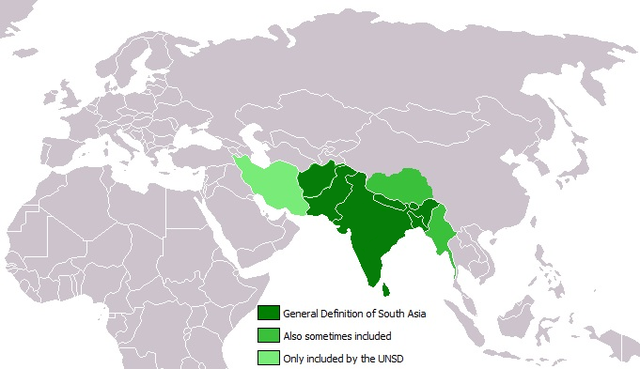คำถามยอดนิยม
ไทมไลน์
แชท
มุมมอง
เอเชียใต้
จากวิกิพีเดีย สารานุกรมเสรี
Remove ads
เอเชียใต้ เป็นอนุภูมิภาคทางตอนใต้ของเอเชีย ซึ่งมีการใช้งานทั้งทางภูมิศาสตร์และชาติพันธุ์-วัฒนธรรม ประเทศที่อยู่ในภูมิภาคนี้ได้แก่ อัฟกานิสถาน,[note 1] บังกลาเทศ, ภูฏาน, อินเดีย, มัลดีฟส์, เนปาล, ปากีสถาน และศรีลังกา[7] ขอบเขตของอนุทวีปทางตอนใต้ติดกับมหาสมุทรอินเดีย ทางตอนเหนือติดกับเทือกเขาหิมาลัย, การาโกรัม และปามีร์ ขอบเขตทางตะวันตกเฉียงเหนือคือแม่น้ำอามูดาร์ยาที่ไหลไปทางเหนือของเทือกเขาฮินดูกูช ส่วนบนพื้นดิน (ตามเข็มนาฬิกา) ติดกับเอเชียตะวันตก เอเชียกลาง เอเชียตะวันออก และเอเชียตะวันออกเฉียงใต้
สมาคมเอเชียใต้เพื่อความร่วมมือระดับภูมิภาค (SAARC) เป็นองค์กรความร่วมมือทางเศรษฐกิจในภูมิภาคที่จัดตั้งขึ้นใน ค.ศ. 1985 และรวม 8 ประเทศในเอเชียใต้[8] เอเชียใต้กินพื้นที่ประมาณ 5.2 ล้าน ตารางกิโลเมตร (2.0 ล้าน ตารางไมล์) ซึ่งเท่ากับ 11.71% ของทวีปเอเชีย หรือ 3.5% ของพื้นผิวโลก[7] ประชากรในเอเชียใต้มีประมาณ 1.9 พันล้านคน[1] หรือประมาณหนึ่งส่วนสี่ของประชากรโลก ทำให้เป็นทั้งภูมิภาคที่มีประชากรมากที่สุดและหนาแน่นที่สุดในโลก[9]
ใน ค.ศ. 2010 เอเชียใต้มีประชากรที่เป็นชาวฮินดู, มุสลิม, ชาวซิกข์, เชน และโซโรอัสเตอร์มากที่สุด[10] โดยในเอเชียใต้อย่างเดียวมีชาวฮินดู 98.47%, ซิกข์ 90.5% และมุสลิม 31% จากทั่วโลก เช่นเดียวกันกับชาวคริสต์ 35 ล้านคนกับชาวพุทธ 25 ล้านคน[11][12][13][14]
Remove ads
นิยาม
สรุป
มุมมอง

คำนิยามสมัยใหม่ของเอเชียใต้มีความสอดคล้องกัน ได้แก่ อัฟกานิสถาน บังกลาเทศ ภูฏาน อินเดีย มัลดีฟส์ เนปาล ปากีสถาน และศรีลังกา[16][17][18] อย่างไรก็ตาม มีคำนิยามบางส่วนจัดให้ประเทศอัฟกานิสถานอยู่ในเอเชียกลาง, เอเชียตะวันตก หรือตะวันออกกลาง[19][20][21][22][23][24] ประเทศนี้เคยตกเป็นรัฐในอารักขาของบริติชหลังสงครามอังกฤษ-อัฟกานิสถานครั้งที่สองจนถึง ค.ศ. 1919[25][16][18] ในทางกลับกัน ประเทศพม่าเคยเป็นส่วนหนึ่งของบริติชราชใน ค.ศ. 1886 ถึง 1937[26] และปัจจุบันเป็นส่วนหนึ่งของเอเชียตะวันออกเฉียงใต้ ในฐานะรัฐสมาชิกอาเซียน บางครั้งมีการรวมเข้าในเอเชียใต้ด้วย[20][21][27] แต่อาณานิคมเอเดน, บริติชโซมาลีแลนด์ และสิงคโปร์ ไม่เคยเสนอเป็นส่วนหนึ่งของเอเชียใต้ แม้ว่าจะเคยอยู่ภายใต้การปกครองของบริติชราชก็ตาม[28] ภูมิภาคนี้อาจรวมดินแดนพิพาทอักไสชิน ซึ่งเคยเป็นส่วนหนึ่งของรัฐมหาราชาชัมมูและกัศมีร์ ปัจจุบันเป็นส่วนหนึ่งในเขตปกครองตนเองซินเจียงอุยกูร์ของจีน แต่อินเดียก็อ้างสิทธิ์ด้วย[29]
ขอบเขตทางภูมิศาสตร์ของเอเชียใต้ไม่ชัดเจน เนื่องจากการวางแนวนโยบายที่เป็นระบบและต่างประเทศของประเทศในนั้นค่อนข้างไม่สมมาตร[20] นอกเหนือจากดินแดนหลักของบริติชราชหรือจักรวรรดิบริติชอินเดียแล้ว ยังมีความหลากหลายที่ประเทศอื่นรวมอยู่ในเอเชียใต้ในระดับสูง[30][21][31][32] ไม่มีขอบเขตที่ชัดเจน ทั้งในทางภูมิศาสตร์ การเมือง สังคมวัฒนธรรม เศรษฐกิจ หรือประวัติศาสตร์ ระหว่างเอเชียใต้และส่วนอื่น ๆ ของเอเชีย โดยเฉพาะอย่างยิ่งในขอบเขตตะวันออกกลางและเอเชียตะวันออกเฉียงใต้[33]
คำนิยามทั่วไปของเอเชียสืบทอดมาจากเขตบริหารของบริติชราช[34] โดยมีข้อยกเว้นบางส่วน ดินแดนที่ปัจจุบันคือบังกลาเทศ อินเดีย และปากีสถาน เคยเป็นดินแดนหลักของจักรวรรดิบริติชใน ค.ศ. 1857 ถึง 1947 ก็เป็นดินแดนหลักของเอเชียใต้[35][36][17][18] ประเทศบนภูเขาอย่างเนปาลและภูฏานไม่ได้เป็นส่วนหนึ่งของบริติชราช[37] และประเทศบนเกาะอย่างศรีลังกาและมัลดีฟส์โดยทั่วไป มีการรวมเข้าไปด้วย ส่วนนิยามต่าง ๆ ที่มีเหตุผลต่างกัน ได้รวมบริติชอินเดียนโอเชียนเทร์ริทอรีและเขตปกครองตนเองทิเบตด้วย[38][39][40][41][42][43][44] รัฐมหาราชา 562 แห่งที่ได้รับความคุ้มครอง แต่ไม่ได้รับการปกครองจากบริติชราชโดยตรง กลายเป็นเขตบริหารของเอเชียใต้เมื่อเข้าร่วมอินเดียหรือปากีสถาน[45][46]
Remove ads
ประวัติ
ก่อนประวัติศาสตร์
ประวัติศาสตร์แกนกลางของเอเชียใต้ที่มีหลักฐานกิจกรรมของมนุษย์ Homo sapiens เริ่มต้นนานสุดที่ 75,000 ปีก่อน หรือถ้ารวมวงศ์ลิงใหญ่อย่าง Homo erectus ก็จะอยู่ที่ประมาณ 500,000 ปีก่อน[47] วัฒนธรรมก่อนประวัติศาสตร์แรกสุดมีต้นตอในยุคหินกลาง ดังปรากฏในหลักฐานจากภาพวาดบนหินที่เพิงหินภีมเพฏกามีอายุประมาณ 30,000 ปีก่อน ค.ศ. หรือเก่ากว่านั้น[note 2] เช่นเดียวกันกับช่วงเวลายุคหินใหม่[note 3]
Remove ads
ประเทศและดินแดน
ประเทศ
ดินแดนที่อาจรวมอยู่ในอนุทวีป
ดูเพิ่ม
- กีฬาภูมิภาคเอเชียใต้
- สภาโอลิมปิกเอเชียใต้
- สหพันธ์ฟุตบอลเอเชียใต้
- อนุทวีปอินเดีย
หมายเหตุ
- Doniger 2010, p. 66: "Much of what we now call Hinduism may have had roots in cultures that thrived in South Asia long before the creation of textual evidence that we can decipher with any confidence. Remarkable cave paintings have been preserved from Mesolithic sites dating from c. 30,000 BCE in Bhimbetka, near present-day Bhopal, in the Vindhya Mountains in the province of Madhya Pradesh."
- Jones & Ryan 2006, p. xvii: "Some practices of Hinduism must have originated in Neolithic times (c. 4000 BCE). The worship of certain plants and animals as sacred, for instance, could very likely have very great antiquity. The worship of goddesses, too, a part of Hinduism today, maybe a feature that originated in the Neolithic."
Remove ads
อ้างอิง
อ่านเพิ่ม
แหล่งข้อมูลอื่น
Wikiwand - on
Seamless Wikipedia browsing. On steroids.
Remove ads


